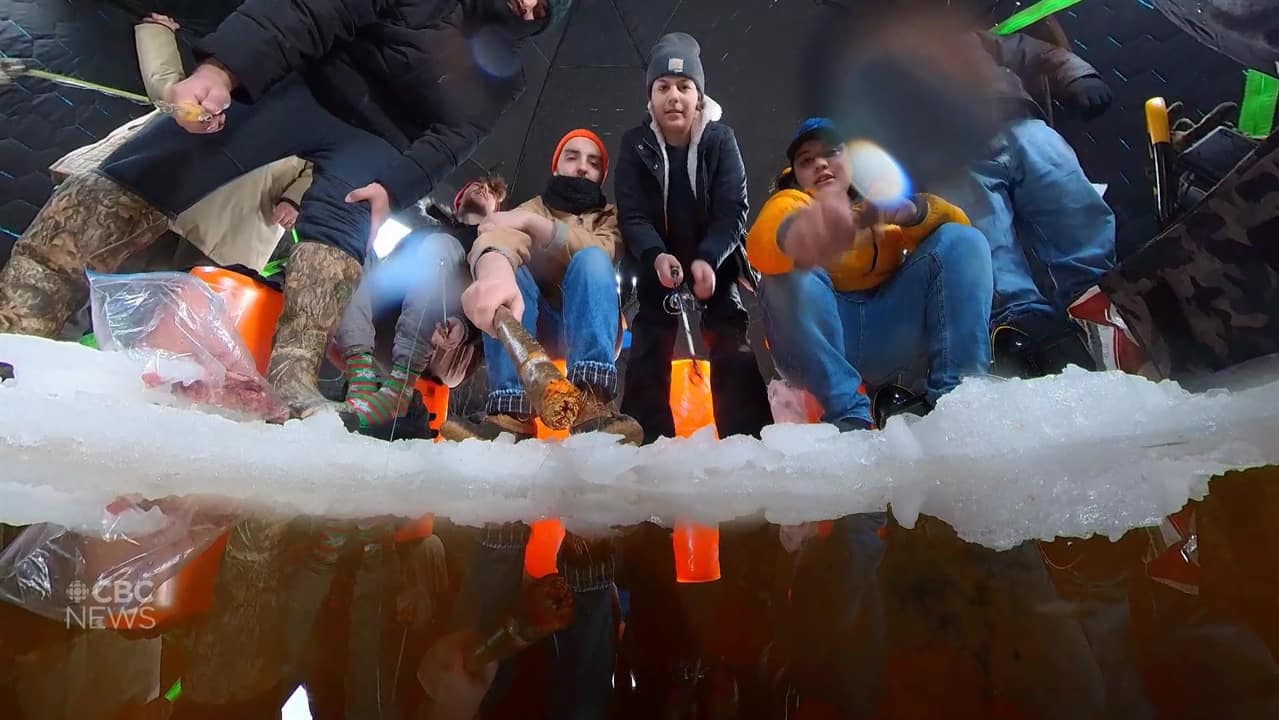Lured by love of ice fishing, Inuk man learns Mi’kmaq techniques in N.B. | CBC News
Venturing out onto New Brunswick’s Richbuctou River, Jordan Takkriuq and his friends were ready to learn how the Mi’kmaq ice fish.
Takkriuq is Inuk from Gjoa Haven, Nunavut, and has been ice fishing in his home community since he was at least seven years old.
He was thrilled to learn the many differences between the nations’ ice fishing styles.
“I’m very surprised that you can feel the fish biting because of how small they are compared to back home. Because back home, they’ll try to drag you down,” said Takkriuq, 20.
He’s talking about the difference between Rainbow smelt and Arctic char.
Commonly caught in New Brunswick, smelt average about 20 centimetres and weigh between one and six ounces. Arctic char average between seven to 11 pounds and about 40 centimetres in length.
WATCH | Nunavut man travels to N.B. to learn Mi’kmaq ice fishing techniques:
One catches char, the other smelt. One uses a branch as a pole, the other prefers bone. Jordan Takkriuq, an Inuk man from Gjoa Haven, Nunavut, goes to Elsipogtog First Nation in New Brunswick, to learn Mi’kmaq ice fishing techniques from Irving Peterpaul. 4:35
Different places, different ice fishing methods
Last Sunday, Takkriuq and his friends came to Elsipogtog First Nation, about 91 km north of Moncton, for the cultural exchange. They were taught the Mi’kmaq techniques by Elsipogtog community member Irving Peterpaul, 44.
Peterpaul has been ice fishing since age four and was taught by his late mother, Anita Peterpaul. He was just as excited to hear stories from Takkriuq and his friends.
“It’s amazing to hear the stories of where they come from,” said Peterpaul. “It’s quite astonishing.”
Mi’kmaq fishers traditionally used branches as poles. Takkriuq said because of his community’s location on the southeastern coast of King William Island above the Arctic Circle, trees are sparse. So instead of branches, they use caribou bone for their fishing poles, with a long fishing line and a single large hook.
They also have to drill through ten feet of ice and each fisher has their own hole. But when they fished with Peterpaul, all six people shared a hole, which was drilled through two feet of ice.
Peterpaul uses a small fishing rod with a fishing line with multiple small hooks, and uses moose meat as bait. He also set up a blue tent with a heater.
Sharing a respect for the catch
Gjoa Haven is 2,995 km from Elsipogtog First Nation, but Takkriuq found both cultures share a respect for anything they catch.
“We use every part of the animal in any animal we hunt. It’s really nice to see that similarity,” said Takkriuq.
He also mentioned the need to fish and hunt to offset the price of groceries. In Gjoa Haven, there is one annual barge shipment of non-perishable goods used to stock grocery stores. In order to combat food shortages, hunting and fishing are a necessity.
Peterpaul says ice fishing is a staple for his winter season. He said a lot of his catch goes to community elders or people in need.
“It makes me feel good to give to others,” he said.
Kailey Trenholm, who identifies as mixed with Cree roots to Fort McKay First Nation in northeast Alberta, spent most of her life in Mi’kma’ki, the homeland of the Mi’kmaq, and was also there to learn.
“My favourite part of Indigenous culture is that everything is passed down orally. So I love hearing the stories of people growing up or what they were taught,” said Trenholm, 20.
She was impressed to learn that eels were a staple of the Mi’kmaq diet and that the Mi’kmaq speared them.
Trenholm is also a student at Mount Allison University where she met Takkriuq. This was just her second time ice fishing but she said she was looking forward to trying it again.
“I love it. I could totally do it again,” said Trenholm.
For all the latest Technology News Click Here

